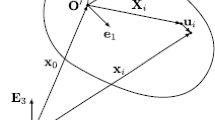Abstract
Design sensitivity analysis of flexible multibody systems is important in optimizing the performance of mechanical systems. The choice of coordinates to describe the motion of multibody systems has a great influence on the efficiency and accuracy of both the dynamic and sensitivity analysis. In the flexible multibody system dynamics, both the floating frame of reference formulation (FFRF) and absolute nodal coordinate formulation (ANCF) are frequently utilized to describe flexibility, however, only the former has been used in design sensitivity analysis. In this article, ANCF, which has been recently developed and focuses on modeling of beams and plates in large deformation problems, is extended into design sensitivity analysis of flexible multibody systems. The Motion equations of a constrained flexible multibody system are expressed as a set of index-3 differential algebraic equations (DAEs), in which the element elastic forces are defined using nonlinear strain-displacement relations. Both the direct differentiation method and adjoint variable method are performed to do sensitivity analysis and the related dynamic and sensitivity equations are integrated with HHT-I3 algorithm. In this paper, a new method to deduce system sensitivity equations is proposed. With this approach, the system sensitivity equations are constructed by assembling the element sensitivity equations with the help of invariant matrices, which results in the advantage that the complex symbolic differentiation of the dynamic equations is avoided when the flexible multibody system model is changed. Besides that, the dynamic and sensitivity equations formed with the proposed method can be efficiently integrated using HHT-I3 method, which makes the efficiency of the direct differentiation method comparable to that of the adjoint variable method when the number of design variables is not extremely large. All these improvements greatly enhance the application value of the direct differentiation method in the engineering optimization of the ANCF-based flexible multibody systems.
Similar content being viewed by others
References
Bauchau, O.A., Laulusa, A.: Review of contemporary approaches for constraint enforcement in multibody systems. J. Comput. Nonlinear Dyn. 3(1), 011005 (2008)
Berzeri, M., Shabana, A.A.: Development of simple models for the elastic forces in the absolute nodal co-ordinate formulation. J. Sound Vib. 235(4), 539–565 (2000)
Berzeri, M., Campanelli, M., Shabana, A.A.: Definition of the elastic forces in the finite-element absolute nodal coordinate formulation and the floating frame of reference formulation. Multibody Syst. Dyn. 5(1), 21–54 (2001)
Bestle, D., Eberhard, P.: Analyzing and optimizing multibody systems. Mech. Struct. Mach. 20(1), 67–92 (1992)
Bestle, D., Seybold, J.: Sensitivity analysis of constrained multibody systems. Arch. Appl. Mech. 62(3), 181–190 (1992)
Bhalerao, K., Poursina, M., Anderson, K.: An efficient direct differentiation approach for sensitivity analysis of flexible multibody systems. Multibody Syst. Dyn. 23(2), 121–140 (2010)
Bischof, C., Carle, A., Corliss, G., Griewank, A., Hovland, P.: Adifor generating derivative codes from fortran programs. Sci. Program. 1(1), 11–29 (1992)
Bischof, C., Khademi, P., Mauer, A., Carle, A.: Adifor 2.0: automatic differentiation of Fortran 77 programs. IEEE Comput. Sci. Eng. 3(3), 18–32 (1996)
Cao, Y., Li, S., Petzold, L.: Adjoint sensitivity analysis for differential-algebraic equations: algorithms and software. J. Comput. Appl. Math. 149(1), 171–191 (2002)
Chang, C.O., Nikravesh, P.E.: Optimal design of mechanical systems with constraint violation stabilization method. J. Mech. Transm. Autom. Des. 107(4), 493–498 (1985)
Dias, J.M.P., Pereira, M.S.: Sensitivity analysis of Rigid-Flexible multibody systems. Multibody Syst. Dyn. 1(3), 303–322 (1997)
Ding, J.Y., Pan, Z.K., Chen, L.Q.: Second order adjoint sensitivity analysis of multibody systems described by differential algebraic equations. Multibody Syst. Dyn. 18(4), 599–617 (2007)
Eberhard, P.: Analysis and optimization of complex multibody systems using advanced sensitivity analysis methods. In: 3rd International Congress on Industrial and Applied Mathematics (ICIAM 95), vol. 76, pp. 40–43. Akademie Verlag, Hamburg (1995)
García-Vallejo, D., Mayo, J., Escalona, J.L., Domínguez, J.: Efficient evaluation of the elastic forces and the Jacobian in the absolute nodal coordinate formulation. Nonlinear Dyn. 35(4), 313–329 (2004)
Greene, W.H., Haftka, R.T.: Computational aspects of sensitivity calculations in transient structural analysis. Comput. Struct. 32(2), 433–443 (1989)
Griewank, A., Reese, S.: On the calculation of Jacobian matrices by the Markowitz rule. In: Griewank, A., Corliss, G. (eds.) Automatic Differentiation of Algorithms: Theory, Implementation, and Applications, pp. 126–135. SIAM, Philadelphia (1991)
Haftka, R.T., Gürdal, Z.: Elements of Structural Optimization, 3rd edn. Springer, Berlin (1992)
Haug, E.J., Ehle, P.E.: Second-order design sensitivity analysis of mechanical system dynamics. Int. J. Numer. Methods Eng. 18(11), 1699–1717 (1982)
Haug, E.J., Wehage, R., Barman, N.C.: Design sensitivity analysis of planar mechanism and machine dynamics. J. Mech. Des. 103(3), 560–570 (1981)
Haug, E.J., Mani, N.K., Krishnaswami, P.: Design sensitivity analysis and optimization of dynamically driven systems. In: Haug, E.J. (ed.) Computer Aided Analysis and Optimization of Mechanical System Dynamics, pp. 555–636. Springer, Heidelberg (1984)
Hsu, Y., Anderson, K.S.: Recursive sensitivity analysis for constrained multi-rigid-body dynamic systems design optimization. Struct. Multidiscip. Optim. 24(4), 312–324 (2002)
Hussein, B., Negrut, D., Shabana, A.A.: Implicit and explicit integration in the solution of the absolute nodal coordinate differential/algebraic equations. Nonlinear Dyn. 54(4), 283–296 (2008)
Laulusa, A., Bauchau, O.A.: Review of classical approaches for constraint enforcement in multibody systems. J. Comput. Nonlinear Dyn. 3(1), 011004 (2008)
Li, S., Petzold, L., Zhu, W.: Sensitivity analysis of differential-algebraic equations: A comparison of methods on a special problem. Appl. Numer. Math. 32(2), 161–174 (2000)
Liu, X.: Sensitivity analysis of constrained flexible multibody systems with stability considerations. Mech. Mach. Theory 31(7), 859–863 (1996)
Maly, T., Petzold, L.R.: Numerical methods and software for sensitivity analysis of differential-algebraic systems. Appl. Numer. Math. 20(1–2), 57–79 (1996)
Mikkola, A.M., Matikainen, M.K.: Development of elastic forces for a large deformation plate element based on the absolute nodal coordinate formulation. J. Comput. Nonlinear Dyn. 1(2), 103–108 (2006)
Mukherjee, R., Bhalerao, K., Anderson, K.: A divide-and-conquer direct differentiation approach for multibody system sensitivity analysis. Struct. Multidiscip. Optim. 35(5), 413–429 (2008)
Negrut, D., Rampalli, R., Ottarsson, G., Sajdak, A.: On an implementation of the Hilber–Hughes–Taylor method in the context of index 3 differential-algebraic equations of multibody dynamics (detc2005-85096). J. Comput. Nonlinear Dyn. 2(1), 73–85 (2007)
Negrut, D., Jay, L.O., Khude, N.: A discussion of low-order numerical integration formulas for rigid and flexible multibody dynamics. J. Comput. Nonlinear Dyn. 4(2), 021008 (2009)
Neto, M.A., Ambrózio, J.A.C., Leal, R.P.: Sensitivity analysis of flexible multibody systems using composite materials components. Int. J. Numer. Methods Eng. 77, 386–413 (2009)
Omar, M.A., Shabana, A.A.: A two-dimensional shear deformable beam for large rotation and deformation problems. J. Sound Vib. 243(3), 565–576 (2001)
Serban, R., Freeman, J.S.: Identification and identifiability of unknown parameters in multibody dynamic systems. Multibody Syst. Dyn. 5(4), 335–350 (2001)
Serban, R., Haug, E.J.: Kinematic and kinetic derivatives in multibody system analysis. Mech. Struct. Mach. 26(2), 145–173 (1998)
Shabana, A.A.: Definition of the slopes and the finite element absolute nodal coordinate formulation. Multibody Syst. Dyn. 1(3), 339–348 (1997)
Shabana, A.A.: Flexible multibody dynamics: Review of past and recent developments. Multibody Syst. Dyn. 1(2), 189–222 (1997)
Shabana, A.A.: Computer implementation of the absolute nodal coordinate formulation for flexible multibody dynamics. Nonlinear Dyn. 16(3), 293–306 (1998)
Sopanen, J.T., Mikkola, A.M.: Description of elastic forces in absolute nodal coordinate formulation. Nonlinear Dyn. 34(1–2), 53–74 (2003)
Wang, X., Haug, E.J., Pan, W.: Implicit numerical integration for design sensitivity analysis of rigid multibody systems. Mech. Based Des. Struct. Mach. 33(1), 1–30 (2005)
Yakoub, R.Y., Shabana, A.A.: Three dimensional absolute nodal coordinate formulation for beam elements: Implementation and applications. J. Mech. Des. 123(4), 614–621 (2001)
Author information
Authors and Affiliations
Corresponding author
Rights and permissions
About this article
Cite this article
Pi, T., Zhang, Y. & Chen, L. First order sensitivity analysis of flexible multibody systems using absolute nodal coordinate formulation. Multibody Syst Dyn 27, 153–171 (2012). https://doi.org/10.1007/s11044-011-9269-4
Received:
Accepted:
Published:
Issue Date:
DOI: https://doi.org/10.1007/s11044-011-9269-4




